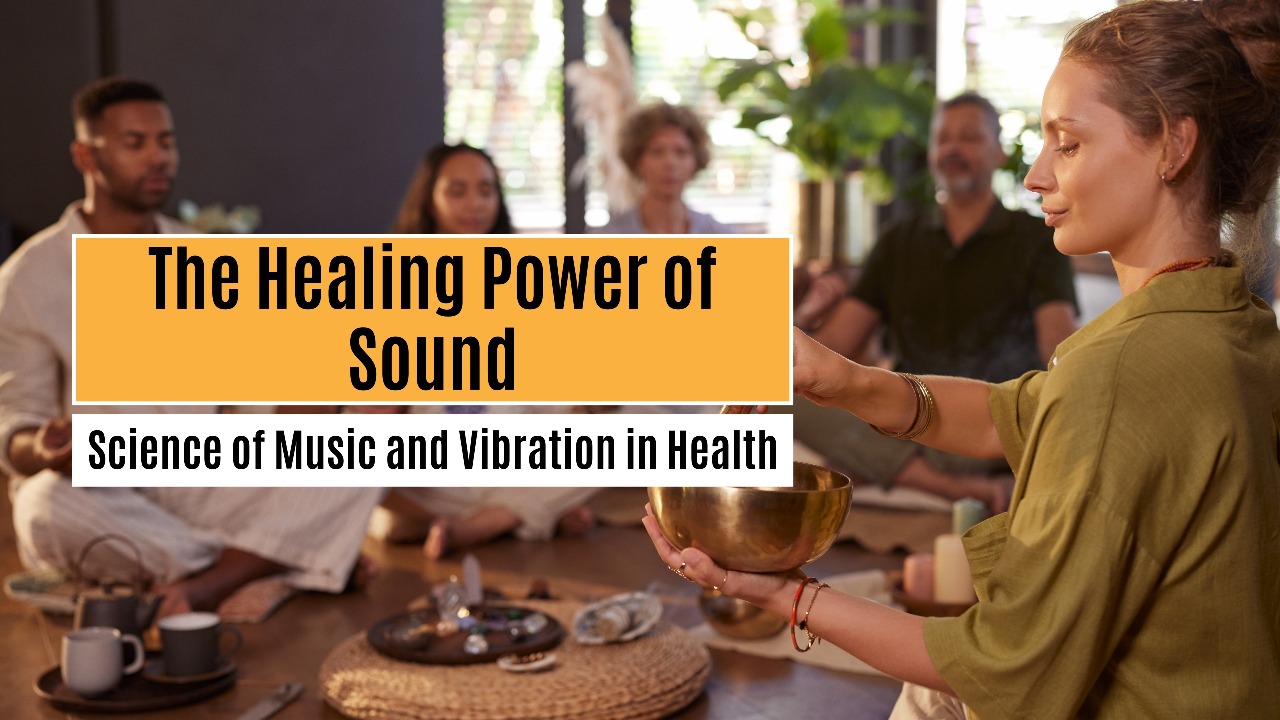Sound is everywhere, in a melody, in the gentle hum of chanting, in the quiet pulse of the Earth itself. For centuries, humans have turned to music, rhythm, and natural sounds for comfort and healing. Sound has long been part of human healing traditions, from the chanting of Om in yoga to lullabies sung for comfort. Today, scientific studies confirm what traditions long suggested: Sound can ease pain, improve sleep, lower stress, and support heart and emotional health, and may also influence immune function by reducing stress-related inflammation.. Whether heard as music, felt as vibration, or experienced in harmony with nature, sound is proving to be a profound ally in health.
🎶 The Restorative Power of Music
Music therapy has become a trusted partner in healthcare. Systematic reviews confirm that listening to music can reduce anxiety and pain, lower heart rate and blood pressure, and decrease stress hormones. Some studies suggest music may help lower stress hormones like cortisol and reduce inflammation, which could indirectly support immune function.
- Mode:Listening to music or actively creating it through singing, drumming, or instrument use.
- Duration: 20-45 minutes, several times per week.
- Best Time: Evening for sleep preparation; daytime for emotional resilience.
🌊 Vibrations That Heal the Body
Some therapies let you not just hear sound but feel it. Vibroacoustic therapy delivers low‑frequency sound (30-120 Hz) through chairs or mats, easing pain, relaxing muscles, and improving circulation.
- Mode: Vibroacoustic devices transmitting low‑frequency sound.
- Duration: 20-30 minutes, 2-3 sessions per week.
- Best Time: Midday or evening when rest is possible.
These vibrations may act like an internal massage, helping the body return to a more coherent physiological rhythm.
🧠 Guiding the Mind Through Rhythm
Our brains naturally move through rhythms; each linked to specific states of health:
- Delta (0.5–4 Hz): deep sleep and cellular repair.
- Theta (4–8 Hz): meditation, emotional processing, creativity.
- Alpha (8–12 Hz): calm focus and reduced stress.
- Gamma (~40 Hz): clarity, learning, and memory.
Sound patterns like binaural beats are believed to encouragethis brain activity associated with particular mental states, though individual responses vary.
- Mode: Gentle binaural beats or rhythmic tones via headphones.
- Duration: 15-30 minutes in a quiet setting.
- Best Time:
- Theta/Delta: before sleep for circadian alignment.
- Alpha: daytime breaks for stress relief.
- Gamma: during focused mental activity.
Health Impact:
- Supports restorative sleep and melatonin regulation.
- Reduces stress and quiets overactive stress circuits.
- Aids trauma recovery by calming the amygdala.
- May support memory and cognitive function, particularly when used during focused tasks.
🌿‘Om’: The Primordial Vibration
In yoga’s ancient texts, ‘Om’ is described as the vibration of creation. Preliminary imaging studies suggest that chanting ‘Om’ may reduce stress-related brain activity and activate the vagus nerve, a key player in relaxation responses, the body’s “rest and restore” system.
- Mode: Soft chanting or humming.
- Duration: 5–20 minutes daily.
- Best Time: Dawn (Brahma Muhurta, 4-6 AM).
- Can be chanted anytime.
Chanting ‘Om’ enhances heart rate variability, reduces anxiety, and supports emotional balance. The vibration resonates through the chest and skull, creating a sense of alignment between body and mind.
🌍 Nature’s Resonance and Human Health
The Earth’s natural electromagnetic frequency (~7.83 Hz), known as the Schumann resonance, coincides with the alpha rhythm of the human brain, although the health implications of this resonance remain largely theoretical.Time in nature exposes us to soundscapes of birds, water, and wind, which have been shown to reduce stress and sharpen cognition.
- Mode: Immersion in natural sound environments.
- Duration:minimum 20 minutes daily.
- Best Time: Morning or evening outdoors.
By contrast, chronic urban noise has been linked with hypertension, poor sleep, and impaired mental health.
🌱 Harmony of Body, Thoughts, and Emotions
Science shows that health is also about internal resonance:
- Calm breathing and chanting improve heart rate variability, a marker of resilience.
- Positive emotions align with healthier physiological rhythms, while stress disrupts them.
- Whole, unprocessed foods reduce inflammation and stabilize mood, fostering coherence between body and mind.
Together, these findings suggest that health emerges when body, mind, environment, and daily choices resonate in balance.
🔬 Frequencies with Scientific Support
While many tones are promoted as “healing,” evidence is strongest for:
- 40 Hz:stimulation has shown potential in early studies to support memory and cognitive function, especially in neurodegenerative conditions.
- 432 Hz: linked with deeper relaxation in preliminary studies.
- 136 Hz (“Cosmic Om”):associated with calming effects in anecdotal reports and some preliminary studies and spiritual practice.
⚠️ Safety, Risks, and Precautions
Sound‑based practices are generally safe, but mindful use is important.
Volume and Exposure:
- Keep sound at a comfortable, non‑straining level. WHO advises <85 dB for under 8 hours daily to protect hearing.
- Begin with shorter sessions (10–15 minutes), extending gradually.
Vibroacoustic Therapy:
- Avoid in those with pacemakers, seizure disorders, or acute thrombosis unless cleared by a doctor.
- Pregnant individuals should avoid direct vibration on the abdomen.
Brainwave Entrainment (Binaural Beats):
- Generally safe, but people with epilepsy or neurological conditions should seek medical advice, as rhythmic auditory stimulation could rarely provoke seizures.
Chanting and Breath Practices:
- Usually safe, but individuals with respiratory or cardiac conditions should chant gently and avoid strain.
- Stop if dizziness or discomfort occurs.
Environmental Soundscapes:
- Natural sounds are beneficial and safe.
- Chronic exposure to urban noise (>65 dB) is associated with hypertension, poor sleep, and cardiovascular strain (WHO, 2018).
General Guidance:
- Sound practices should complement, not replace, standard medical care.
- Responses differ by individual; some may find certain sounds overstimulating.
- Take professional guidance for children, elderly, or those with health conditions.
- In modern life, even healing sounds are often consumed via earphones and screens, which may carry risks like digital fatigue or auditory strain, so use with care.
🌟 Living in Harmony
Sound reminds us that health is not simply the absence of disease, it is harmony: within the body, in our emotions and thoughts, in what we eat, what we do, and with the Earth itself.
Whether through calming music, felt vibrations, the timeless resonance of ‘Om’, or the quiet ‘hum of nature’, tuning into sound helps us reconnect with rhythms greater than our own.
And in that harmony, health finds its rhythm.
📚 References:
- Bradt J, Dileo C, Shim M. Music interventions for mechanically ventilated patients. Cochrane Database Syst Rev. 2018;2018(6):CD006902.
- Fancourt D, Ockelford A, Belai A. The psychoneuroimmunological effects of music: a systematic review and a new model. Brain Behav Immun. 2014;36:15‑26.
- Erkkilä J, Punkanen M, Fachner J, et al. Individual music therapy for depression: randomized controlled trial. Br J Psychiatry. 2011;199(2):132–139.
- Lahoria G, Maletić-Savatić M, Gerbarg P, et al. Low-frequency sound stimulation while speaking versus passive listening to the same stimuli: pilot findings in fibromyalgia patients. Pain Manag. 2022;12(1):27–35.
- Naghdi L, Ahonen H, Macario P, et al. The effect of low-frequency sound stimulation on patients with fibromyalgia: a clinical study. Pain Res Manag. 2015;20(1):e21–7.
- Kalyani BG, Venkatasubramanian G, Arasappa R, et al. Neurohemodynamic correlates of “OM” chanting: a pilot functional magnetic resonance imaging study. Int J Yoga. 2011;4(1):3–6.
- Telles S, Nagarathna R, Nagendra HR. Autonomic changes during “OM” meditation. Indian J Physiol Pharmacol. 1995;39(4):418–420.
- Buxton RT, Pearson AL, Allou C, Fristrup K, Wittemyer G. A synthesis of health benefits of natural sounds and their distribution in national parks. Proc Natl Acad Sci U S A. 2021;118(14):e2013097118.
- Roberts H, van Lissa C, Hagedoorn P, Kellar I, Helbich M. The effect of short‑term exposure to the natural environment on depressive mood: a systematic review and meta‑analysis. Environ Res. 2019;177:108606. doi:10.1016/j.envres.2019.108606
- Zhu R, Yuan L, Pan Y, Wang Y, Xiu D, Liu W. Effects of natural sound exposure on health recovery: a systematic review and meta‑analysis. Sci Total Environ. 2024;921:171052. doi:10.1016/j.scitotenv.2024.171052
- Lehrer PM, Gevirtz R. Heart rate variability biofeedback: how and why does it work? Front Psychol. 2014;5:756.
- Jespersen KV, Koenig J, Jennum P, Vuust P. Music for insomnia in adults. Cochrane Database Syst Rev. 2015;2015(8):CD010459.
- Trappe HJ. The effects of music on the cardiovascular system and cardiovascular health. Heart. 2010;96(23):1868–1871.
- World Health Organization. Environmental Noise Guidelines for the European Region. Copenhagen: WHO Regional Office for Europe; 2018.

Written by Dr Yadhushree P V

